Disclaimer
The Dover Public Library website offers public access to a wide range of information, including historical materials that are products of their particular times, and may contain values, language or stereotypes that would now be deemed insensitive, inappropriate or factually inaccurate. However, these records reflect the shared attitudes and values of the community from which they were collected and thus constitute an important social record.
The materials contained in the collection do not represent the opinions of the City of Dover, or the Dover Public Library.
The Cochecho Massacre
For over half a century following Dover's founding in 1623, the English settlers co-existed peacefully with the local Penacook tribe. The Indians helped the colonists to develop fishing, hunting and farming skills necessary to surviving in New England. The Indian chieftain was Passaconaway, a strong leader who commanded respect and peaceful behavior from his people. He was responsible for forming the Penacook confederacy, a unification of local tribes against the hostile Mohawks. Passaconaway's 50 year reign marks one of the most peaceful periods in the New Hampshire province. His son Wonalancet took over leadership of the tribe in 1665 and continued his father's peaceful ways.
The leader of the colonists at Cochecho was Richard Walderne (Waldron), an Englishman who had emigrated in 1635. In 1642, Walderne owned a large tract of land at the Lower Falls of the Cochecho River where he built a sawmill. That spot became the foundation of the settlement known as Cochecho.By 1666 a total of 41 families lived and worked here. Indians became a familiar sight around town when Walderne opened a large trading post.There were occasional problems with the Indians. Walderne was not above breaking laws which forbade selling liquor or firearms to Indians.
In 1676, many Indians fled Massachusetts due to bloody fighting between a confederation of Indian tribes and English settlers. By September, over 400 Indians were at the the Cochecho settlement. Half of them were strangers, the other half were Wonalancet's people. Two companies of Massachusetts soldiers arrived to recapture the escaping Indians. They were ready to battle the Indians but Major Walderne intervened.
Walderne agreed that the Massachusetts Indians should be returned to Boston for punishment, but he did not want local, loyal Indians to be harmed in the process. The major suggested a "sham battle". The Indians were invited to assemble close to town for a day of war games. The unsuspecting Indians were surrounded by four militia companies which separated out the local Indians. Over 200 of the Massachusetts Indians were taken back to Boston. Some of them were hanged or sold into slavery.
Tensions mounted between the settlers and the Penacook Indians over the next eleven years. The peaceful Chief Wonalancet was replaced by the warlike Kancamagus who bitterly resented the injustices meted out by English settlers to his people. Indians had no right to travel in the woods east of the Merrimack without written permission from Major Walderne. More and more land was seized from the Indians for paltry payments like a "peck of corn annually for each family".
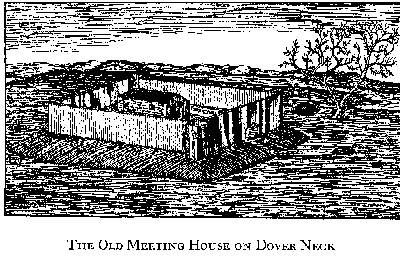
In 1684, the Governor ordered that the meeting house at Dover be fortified against Indian attacks. Every neighborhood developed at least one fortified blockhouse where people could flee to safety if Indians attacked. It is estimated that there were 50 garrisons within a 15 mile radius of present day downtown Dover. Five homes at the Cochecho settlement were garrisoned at public expense. Richard Walderne's, Richard Otis's and Elizabeth Heard's on the north side of the river, Peter Coffin's and his son Tristam's on the south side. These sites were purposefully chosen because of their locations on the highest knolls of the town. The garrisons were built with foot-thick squared logs impenetrable to bullets and a second story which projected over the lower story by two to three feet. This overhang feature was designed to combat Indians who customarily attacked with fire or smoke. A loose board in the overhang could be removed in order to pour boiling water on marauders or on fires below. Each wall also had narrow slits for firearms. The garrisons were also surrounded by an eight foot palisade of large logs set upright in the ground.
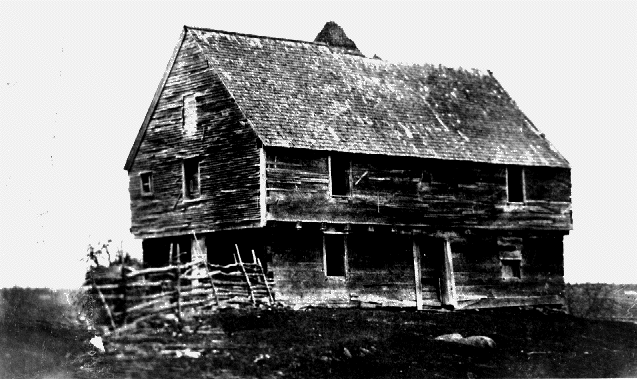
The settlers at Cochecho became frightened by the large number of hostile Indians now living with the local tribe. The settlers took refuge at the blockhouse each night, and during the day, guns were kept close to hand in the fields. Major Walderne scoffed at the fears of his neighbors, boasting he could raise a militia by lifting up his finger. Loyal Indians also tried to warn Walderne of the impending massacre.
Governor Bradford dispatched a letter to Walderne on June 27, stating "Some Indians...report that there is a gathering of Indians in or about Penacook with the designe of mischief to the English...they have a particular designe against yourselfe and Mr. Peter Coffin which the Council thought it necessary ...to give you notice that you take care of your own Safeguard, they intending to endeavor to betray you on a pretention of Trade". The letter arrived one day too late.
On the evening of June 27, several Indian women asked to shelter at each of the garrison houses, a common practice in peacetime. They were shown how to open the doors and gates in case they wanted to leave in the night. No watch was kept as all the Cochecho families retired for the night. During the early hours, Indian women quietly opened the gates to several hundred Penacooks.
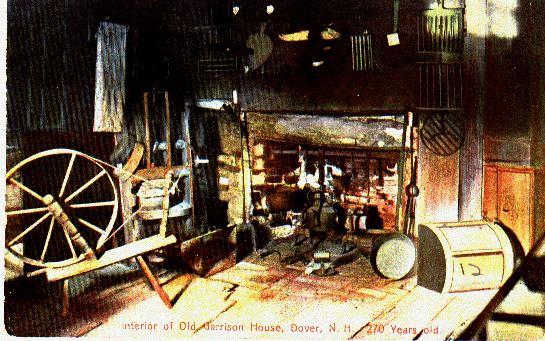
The Indians rushed into Major Walderne's garrison. He attempted to defend himself with a sword but was quickly overpowered and tied to a chair. The furious Penacooks each slashed the 74 year old man across the chest with his own sword, crying out " I cross out my account!" They hacked off his nose and ears then thrust them into his mouth. Finally, they forced him to fall upon his sword. Even in death, the Indians were not done with vengeance: they cut off the hand that had cheated them by holding down down the scales during trading. The final act of revenge was to burn the house to the ground, and murder or take captive the rest of Walderne's family.
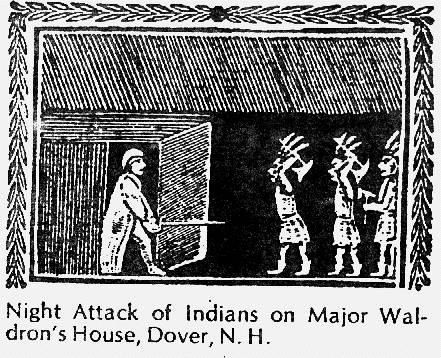
At Richard Otis's garrison the scene was similar. Otis, his son Stephen and daughter Hannah were killed. His wife, Grizel and three month old daughter Margaret as well as two of his grandchildren were taken captive to Canada. Little Margaret (rechristened Christine by French nuns who raised her in Quebec) later returned to Dover at age 45 and opened a tavern. The Otis garrison was also burned to the ground.
The Heard garrison was more fortunate.Elder William Wentworth was guarding the property in the absence of its owner, Elizabeth Heard.He was awakened by a barking dog and managed to close the gates against attack. This was the only garrison left totally unscathed that night. Elizabeth Heard, her three sons, her daughter, and their families were all returning from their voyage to Portsmouth with the dawn tide. After landing, they found the Main Street docks curiously deserted. They cautiously approached the closest garrison, that of Major Walderne. The smell of smoke and the chilling sound of Indian cries alerted them to their peril.
Mrs. Heard was so overcome with fright that she could not go on. She pleaded with her family to leave her and flee for their lives. Regretfully, they left her hidden in some nearby bushes. As daylight broke, an Indian spotted Mrs. Heard in the nearby thicket. He raised his gun and aimed it at her. He stared hard at her face, then silently ran away, never revealing her to his tribesmen. In a curious twist of fate, Elizabeth Heard had saved the life of this Indian during the sham battle. He had never forgotten her kindness and took this opportunity to repay the favor.
Mrs. Heard remained hidden in the thicket until all the Indians left Cochecho. She wearily returned to her home expecting to find burnt ruins. Thanks to her courageous neighbor, William Wentworth, she found her home and family intact.
Across the Cochecho River, Peter Coffin's garrison was quickly overwhelmed by the Indians. Because of his friendly relations with the Indians they did not burn his house, merely looted it. He and his family were taken captive and brought to his son Tristam's garrison. Tristam's home was so well fortified that the Indians had not been able to penetrate it. Kancamagus' men forced him to surrender by holding Peter in front of the gates and threatening to kill him. Tristam's house was not burned, just pillaged. Both Coffin families escaped safely while their captors were busily plundering their homes.
Five or six more homes were burned as were the mills at the Lower Falls. Twenty-three people were killed and twenty-nine were taken captive. On the morning after the massacre, survivors searched the town thoroughly, but the enemy had vanished. Swift pursuit resulted in the re-capture of three Otis daughters in the town of Conway. Added military aid from Massachusetts was soon dispatched to Cochecho, but no further attack was made.
Several years passed before Cochecho fully recovered. Houses and mills were rebuilt, but the loss of so many persons (about 25% of the population) was a severe blow to the settlement's prosperity. By 1700 however, the town had begun to resume its former importance. Although Cochecho was occasionally harassed by Indians, it was never again the target of so destructive a raid.
For the next sixty years, Indian raids continued to plague many other nearby seacoast towns: Oyster River, Salmon Falls, Lee, Exeter, Kingston, Newmarket, Rochester, York, and Eliot all suffered tragedies similar to Cochecho's. Yet by the middle of the 18th century, disease, famine, and the "white tide" had all taken their toll on the Indian population in New Hampshire. By 1770, hardly an Indian remained in the province.
From the 1989 Heritage Walk Tour Booklet.
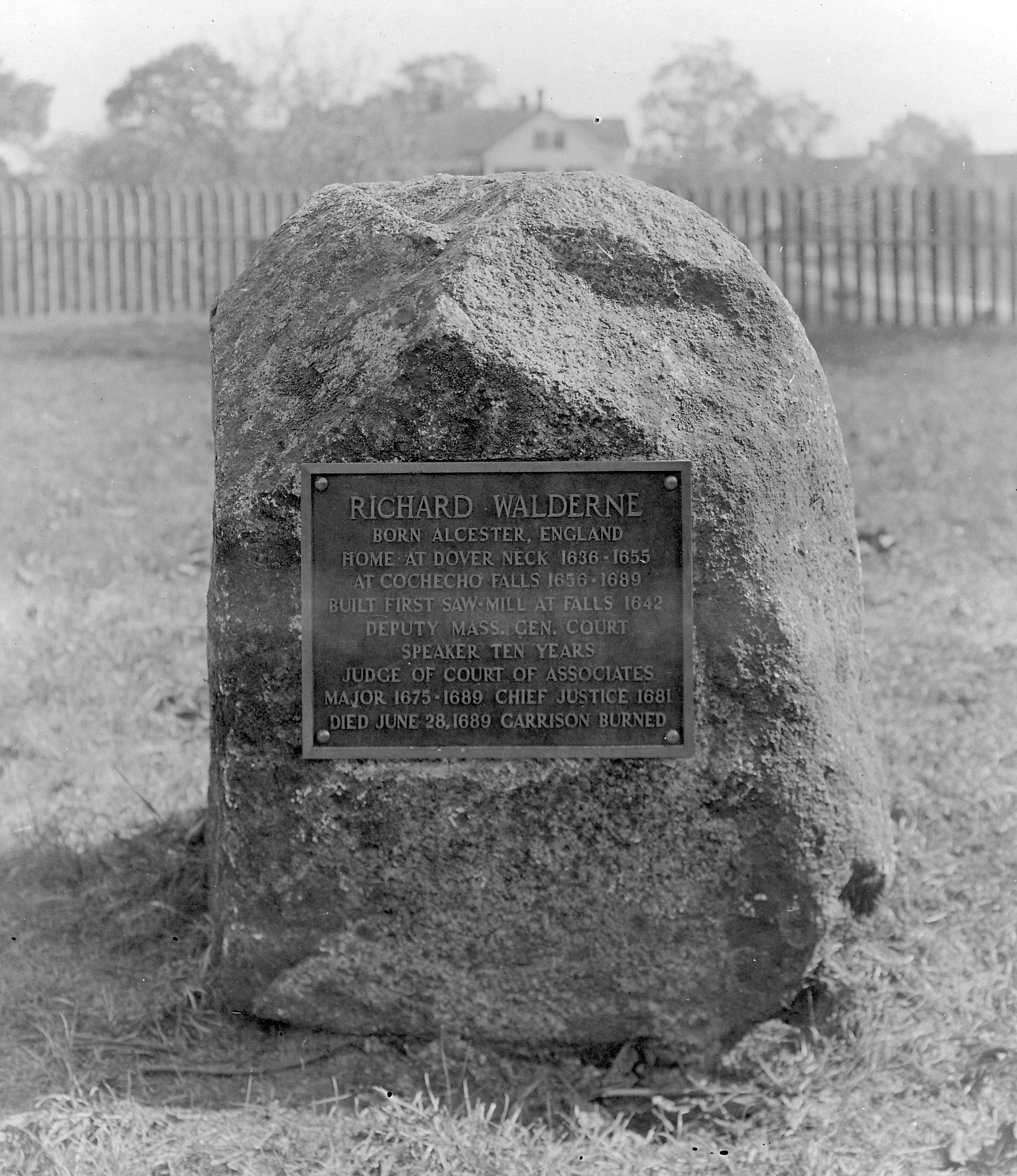
For more information on indigenous people in the Dover area, look at these books available at the Dover Public Library and the listed websites.
Belknap's History of New Hampshire: an account of the State in 1792, V. III by Jeremy Belknap, c. 1973.
Our Beloved Kin : a new history of King Philip's war by Lisa Tanya Brooks, c. 2018.
https://www.ourbelovedkin.com/awikhigan/index (enter Waldron into the search engine)
The Captivity at Cocheco
William Waldron's Defense:The Capture and Return of Wabanaki Noncombatants
Colby's Indian History by Solon B. Colby, c. 1975.
In the Devil's Snare: the Salem witchcraft crisis of 1692 by Mary Beth Norton, c. 2002.
Indian Heritage of New Hampshire and Northern New England by Thaddeus Piotrowski, c. 2002.
Dawnland Encounters : Indians and Europeans in Northern New England / compiled and edited by Colin G. Calloway, c. 1991.
Historical Memoranda Concerning Persons & Places in Old Dover, N.H. by John Scales, c. 1900.
History of Dover, NH by John Scales, c. 1923.
Dawnland Voices: An Anthology of Indigenous Writing from New England by Siobhan Senier, c. 2014.
Indigenous People of Piscataqua Watershed: A Dover400 Lecture
This online presentation is the first session in the Dover400 2021 lecture series, and pays tribute to the Native people who occupied our region prior to colonization by white settlers.
The History of Manchester, formerly Derryfield, in New Hampshire; including that of ancient Amoskeag, or the middle Merrimack valley; together with the address, poem, and other proceedings, of the centennial celebration, of the incorporation of Derryfield; at Manchester, October 22, 1851. By Chandler Eastman Potter, 1856.
"The History of Concord, From Its First Grant in 1725 - To the Organization of the City Government In 1853, With a History of the Ancient Penacooks" By Nathaniel Bouton
by Benning W. Sanborn, 1856. Indian History
"History of Concord, New Hampshire From the Original Grant in Seventeen Hundred and Twenty-Five to the Opening of the Twentieth Century" Prepared Under the Supervision of the City History Commission, James O. Lyford, Editor, 1903. Aboriginal Occupation
This historical essay is provided free to all readers as an educational service. It may not be reproduced on any website, list, bulletin board, or in print without the permission of the Dover Public Library. Links to the Dover Public Library homepage or a specific article's URL are permissible.
